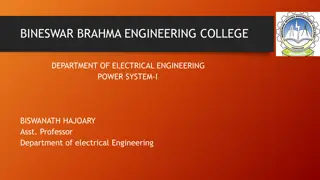Understanding Insulation and Energy Saving in Grade 7 Natural Sciences
Exploring heat loss, gain, and insulation techniques in the context of energy conservation. Topics include solar water heaters, conduction, convection, and radiation as mechanisms for heat transfer.
Download Presentation

Please find below an Image/Link to download the presentation.
The content on the website is provided AS IS for your information and personal use only. It may not be sold, licensed, or shared on other websites without obtaining consent from the author. Download presentation by click this link. If you encounter any issues during the download, it is possible that the publisher has removed the file from their server.
E N D
Presentation Transcript
Natural Sciences Grade 7 Term 3: Energy and Change Insulation and energy saving
Topic 4 Insulation and energy saving Heat loss and gain Natural Sciences - Grade 7
Heat loss and gain Heat loss and gain Heat energy is lost to the environment by conduction, convection and radiation. The human body loses heat through radiation. A geyser can lose heat through conduction through the casing of the geyser and through convection through the air surrounding the geyser. Food cooked over a fire loses heat by convection. Warm beverages lose heat through conduction through the cup it is in as well as through convection above the surface of the liquid [e.g. coffee; milo; tea; etc.]. Insulators such as a geyser blanket can be used to restrict heat loss. Picture [a rooftop hot water geyser]. Natural Sciences - Grade 7
Heat energy can also be gained or absorbed from the Heat energy can also be gained or absorbed from the environment environment Solar geysers absorb heat from the sun through radiation. Convection currents from a heater warm up the air in a room. The food in a pot on a gas / electric stove gains heat through conduction. Natural Sciences - Grade 7
Solar water heaters Solar water heaters Solar energy comes from the sun. The water in our homes can be heated directly through solar energy. The heat of the sun heats the solar water heaters. Natural Sciences - Grade 7
A solar water heater works as follows: A solar water heater works as follows: The cold water flows through the solar heater s pipes. The water in the solar heater s black pipes on the roof is heated by the Sun. [Picture: How a roof top hot water geyser works]. It is important that the heater faces the direction that gets the most Sun during the day [Face south homes in northern hemisphere; face north homes in southern hemisphere. The heated water flows into the hot cylinder. The hot cylinder is connected to the house s water pipes. Natural Sciences - Grade 7























